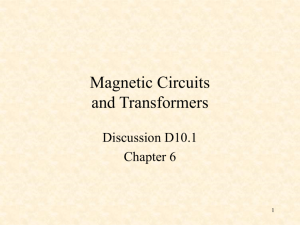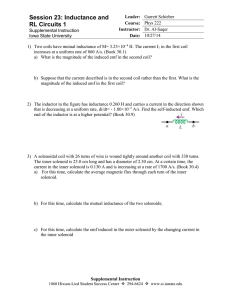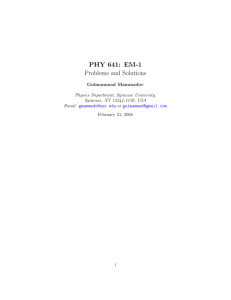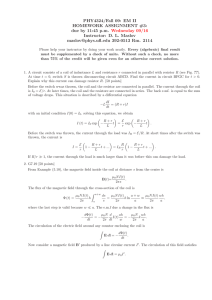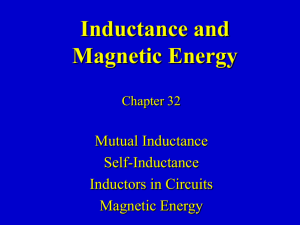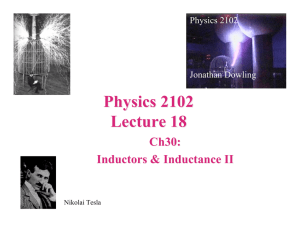Flux Linkage and Inductance
advertisement
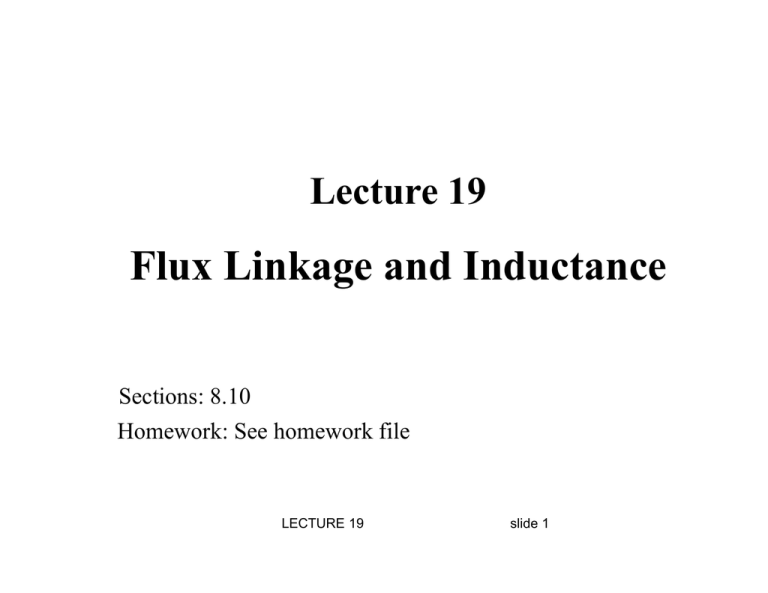
Lecture 19 Flux Linkage and Inductance Sections: 8.10 Homework: See homework file LECTURE 19 slide 1 Flux Linkage in Coils • the sum of all fluxes piercing the surfaces bounded by all turns (the total flux “linking” the turns) • ideal scenario: each turn creates the same flux Φ and this flux “links” all turns (no leakage) N , Wb I 1 • if flux density B is uniform inside the coil the flux linkage is 2 B NI N 2 I NBS , Wb N • this is the coil’s self-flux linkage, i.e., the flux links to the current which generates it LECTURE 19 BS N slide 2 Self and Mutual Flux Linkage • flux linkage may be self-flux linkage and mutual-flux linkage • self-flux linkage links current which it is due to • every coil has self-flux linkage • mutual-flux linkage is due to currents in other inductors I1 B1 • mutual-flux linkage implies two coupled coils LECTURE 19 1 I2 1 2 2 1 11 12 , 2 22 21 11 N111 N12 I1 12 N112 N1 N 2 I 2 22 N 2 22 N 22 I 2 21 N 2 21 N 2 N1I1 B2 11 N1 12 21 slide 3 N2 22 Self and Mutual Inductance • self inductance L shows the amount of self-flux linkage due to unit current self L , H = Wb/A I • mutual inductance M shows the amount of mutual flux linkage due to unit current producing this mutual flux mutual M ,H I • self inductance (or simply inductance) is defined for a single inductor • mutual inductance is defined for a pair of inductors LECTURE 19 slide 4 Example – Self Flux Linkage and Inductance of Toroid N I H , H/m, 1 2 (see L16) 2 h 2 0 1 C B NIh 2 H d dz ln 2 1 2 0 1 B N 2 Ih 2 ln , Wb N 2 1 N 2h 2 ln , H L 2 1 • if toroid is thin, field is mostly uniform N I NIA N 2A H L 20 20 20 d av LECTURE 19 w I z h I B 0 0.5( 1 2 ) A h ( 2 1 ) w slide 5 Homework Find the inductance of a toroid consisting of 200 turns. Its crosssection is of width and height w = h = 1 cm and its inner radius is ρ1 = 1.5 cm. The toroid has a ferromagnetic core whose relative permeability is μr = 400. [Ans.: L ≈ 16.3 mH] LECTURE 19 slide 6 Example for Mutual Flux Linkage and Mutual Inductance • two coaxial solenoids (assume uniform field is in cross-sections) solenoid #1: radius a, length D1, N1 turns a solenoid #2: radius b, length D2, N2 turns b a, D2 D1 b • solenoid #2 is smaller than solenoid #1 and is positioned in its middle N 1 I1 N1 I1 b2 2 H1 21 H1 b D1 D1 N1 N 2 I1 b2 21 N 2 21 D1 M 21 N1 N 2 b2 21 ,H I1 D1 LECTURE 19 slide 7 Physical Significance of Flux Linkage: Faraday's Law Why is the flux linkage important rather than the flux itself? The answer is given by Faraday’s law of EM induction d e, V dt If the magnetic flux changes in time, electromotive force e (V) is induced in each turn of the coil. Each turn acts like an AC voltage source. These equivalent voltage sources are connected in series, thus producing an overall voltage at the coil’s terminations as d d E Ne N , V dt dt It is the rate of change in time of the flux linkage, which determines the induced voltage of a coil: d dI dI k V E L , V or V j M jk dt dt dt LECTURE 19 slide 8 Inductance per Unit Length: Coaxial Cable linkage per unit length determines inductance per unit length L , H/m I I c b 0 I , T (Ampère’s law) 2 0 I d d B d d 2 B H b 0 I 0 I b ln , Wb/m d 2 2 a a L2 0 b ln , H/m 2 a LECTURE 19 a slide 9 Inductance per Unit Length: Parallel-plate Line w • express flux linkage PUL in terms of H field B ( hl ) H ( hl ) Hh area l • express H field in terms of current I using Ampère’s law C H dL Hw I h h 0 , H/m I w LECTURE 19 I H • find inductance PUL Lꞌ L Ampère’s contour slide 10 Obtaining Inductance from Capacitance Expressions • compare the capacitance and inductance PUL expressions for a coaxial line L ln b / a , H/m 2 2 C , F/m ln(b / a ) • and for a parallel-plate line w h C L h w • it can be shown that for any infinitely long TL structure LC the inductance PUL formula can be obtained from the reciprocal of the capacitance formula where ε is replaced by 1/μ LECTURE 19 slide 11 Inductance per Unit Length: Twin-Lead Line C 2 h h ln 1 r r , F/m if h r 2 h h 0 h 0 2 h 0 ln 1 arccosh , H/m L L ln r r r r y h h P 1 s B I A s Az 0 r 2 0 equipotentials Az LECTURE 19 r x B I A slide 12 You have learned: that the inductance of a structure is proportional to the flux linkage that the flux linkage is proportional not only to the number of turns generating the flux but also to the number of turns intercepting this flux that the self inductance of a coil is proportional to N2 that the mutual inductance of a pair of coils is proportional to N1N2 how to calculate the inductance per unit length of transmission lines LECTURE 19 slide 13
